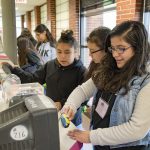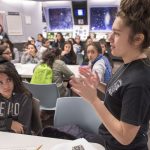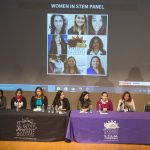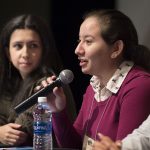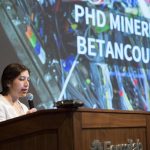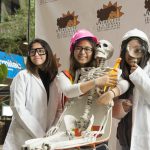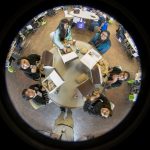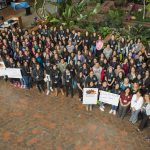Katya Perez left Ecuador and came to America at age 18, speaking no English. Years later, she spoke to an eager crowd of Latina girls about how she followed her dreams and became a chemical engineer.
On April 29, Fermilab hosted for the second time the annual STEM conference by Dare to Dream: Get Educated!, a local program focused on empowering young Latinas to succeed. More than 100 Latina middle and high schoolers and their parents attended and participated in workshops, heard from speakers, and took a tour around the lab. The free event is designed to be an educational and vocational resource and source of inspiration for the young women who attend.
Over 50 million people in the United States have Hispanic origins, but as of 2013, only 4.4 million Latinos 25 or older had a bachelor’s degree or more. Events such as Dare to Dream work to help bridge this disparity in education, particularly as it applies to STEM careers, in which Latinos are underrepresented.
Cassie Carmona, a Dare to Dream volunteer and alumna of Dare to Dream, said that the event can help because STEM careers are often outside of young girls’ comfort zones.
To help facilitate the event, Fermilab staff, led by physicist Minerba Betancourt and members of Fermilab’s Hispanic/Latino Forum, worked to make sure everything ran smoothly. The forum, a lab resource group, works to further opportunities for Latinos at Fermilab and in the surrounding community.
Lab employees Aria Soha and Jeny Teheran, as well as Erika Cataño Mur, a visiting graduate student, participated on a panel of Latina women who discussed their experiences getting into STEM careers. Tours around the lab were given by visiting graduate students, postdoctoral researchers and Fermilab scientists. Additionally, Fermilab scientists and engineers joined the young women during lunch to talk about STEM careers.
The Dare to Dream conference, which is in its 10th year, has previously been held at a local college. Hosting it at Fermilab allows participants the advantage of seeing science up close.
“Here there’s a chance to meet real scientists, see our facilities, what it is that we do here,” Betancourt said. “It’s inspirational.”




